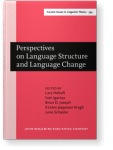Morphosyntactic reanalysis in Australian languages
Three studies
This paper discusses three examples of reanalysis in the Pama-Nyungan languages of Australia, affecting word, clause, and sentence level constructions respectively. The elimination of a morpheme boundary, with absorption of an erstwhile suffix into the nominal stem, in Western Desert dialects revisits and amplifies earlier discussion from Koch (1995), canvassing various motivations and finding supporting data more recent data from Langlois (2004). Secondly, the gradual implementation of the effects of a change from ergative to accusative alignment in Panyjima, as established by Dench (1982), are explored within Andersen’s framework of actualisation. The third study shows, on the basis of the etymology of formal markers, how, in the Arandic languages, biclausal structures have developed via auxiliarisation into inflectional markers of imperfective aspect, but also into a set of inflections realising contrasting values within a new morphosyntactic category of “associated motion”. This section articulates the diachronic developments behind the synchronic system, building on earlier suggestions by Koch (1984) and Wilkins (1991).
Article outline
- 1.Introduction and overview
- 2.Boundary loss with creation of morphological zero
- 3.Reanalysis of alignment: Ergative to accusative
- 4.Clause fusion to auxiliary constructions and inflections marking Associated Motion
- 5.Summary and conclusions
-
Notes
-
References
References (34)
References
Anderson, Stephen R. 1977. On mechanisms by which languages become ergative. In Charles N. Li (ed.), Mechanisms of syntactic change, 317–363. Austin: University of Texas Press.
Austin, Peter. 1989. Verb compounding in Central Australian languages. La Trobe Working Papers in Linguistics 2. 43–71.
Blake, Barry J. 1977. Case marking in Australian languages. Canberra: Australian Institute of Aboriginal Studies.
Bowe, Heather J. 1990. Categories, constituents, and constituent order in Pitjantjatjara: An Aboriginal language of Australia. London: Routledge.
Dench, Alan. 1982. The development of an accusative case marking pattern in the Ngayarda languages of Western Australia. Australian Journal of Linguistics 2. 43–59. 

Dench, Alan. 1991. Panyjima. In R. M. W. Dixon & Barry J. Blake (eds.), Handbook of Australian languages, Volume 4: The Aboriginal language of Melbourne and other grammatical sketches, 124–243. Melbourne: Oxford University Press.
Dench, Alan. 2007. Demonstrative paradigm splitting in the Pilbara languages. In Joseph C. Salmons & Shannon Dubenion-Smith (eds.), Historical linguistics 2005: Selected papers from the 17th International Conference on Historical Linguistics, Madison, Wisconsin, 31 July – 5 August 2005, 223–237. Amsterdam: John Benjamins. 

Dixon, R. M. W. 2002. The Australian languages: Their nature and development. Cambridge: Cambridge University Press. 

Guillaume, Antoine. 2016. Associated motion in South America: Typological and areal perspectives. Linguistic Typology 20(1). 81–177. 

Guillaume, Antoine and Harold Koch (eds.) Forthcoming. Associated Motion. (Empirical Approaches to Linguistic Typology), Berlin: de Gruyter Mouton.
Hale, Kenneth. 1973. Deep-surface canonical disparities in relation to analysis and change. In T. A. Sebeok (ed.), Current trends in linguistics, Volume 11: Diachronic, areal, and typological linguistics, 401–458. The Hague: Mouton. 

Harris, Alice C., & Lyle Campbell. 1995. Historical syntax in cross-linguistic perspective, (Cambridge Studies in Linguistics 74). Cambridge: Cambridge University Press. 

Koch, Harold. 1984. The category of ‘associated motion’ in Kaytej. Language in Central Australia 1. 23–34.
Koch, Harold. 1995. The creation of morphological zeroes. In Geert Booij & Jaap van Marle (eds.), Yearbook of Morphology 1994, 31–71. Dordrecht: Kluwer.
Koch, Harold. 2003. Morphological reconstruction as an etymological method. In Barry J. Blake & Kate Burridge (eds.), Historical linguistics 2001: Selected papers from the 15th International Conference on Historical Linguistics, Melbourne, 13-17 August 2001, 271–291. Amsterdam: John Benjamins. 

Koch, Harold. 2004. The Arandic subgroup of Australian languages. In Claire Bowern & Harold Koch (eds.), Australian languages: Classification and the comparative method. (Current Issues in Linguistic Theory 249), 127–150. Amsterdam: John Benjamins. 

Koch, Harold. 2009. On reconstructing pronominal proto-paradigms: Methodological considerations from the Pama-Nyungan language family of Australia. In Bethwyn Evans (ed.), Discovering history through language: Papers in honour of Malcolm Ross (Pacific Linguistics 605), 317–344. Canberra: Australian National University.
Koch, Harold. 2015. Morphological reconstruction. In Claire Bowern & Bethwyn Evans (eds.), The Routledge handbook of historical linguistics, 286–307. London: Routledge.
Koch, Harold, & Rachel Nordlinger (eds.). 2014. The languages and linguistics of Australia: A comprehensive guide (The World of Linguistics 3). Berlin: de Gruyter Mouton. 

Koch, Harold & Myfany Turpin. In preparation. A grammar of the Kaytetye language of Central Australia.
Langacker, Ronald W. 1977. Syntactic reanalysis. In Charles N. Li (ed.), Mechanisms of syntactic change, 57–139. Austin: University of Texas Press.
Langlois, Annie. 2004. Alive and kicking: Areyonga teenage Pitjantjatjara (Pacific Linguistics 561). Canberra: Australian National University.
McConvell, Patrick. 1981. How Lardil became accusative. Lingua 55. 141–179. 

Simpson, Jane. 2001. Preferred word order and the grammaticalization of Associated Path. In Miriam Butt & Tracy Holloway King (eds.), Time over matter: Diachronic perspectives on morphosyntax, 173–208. Stanford: Centre for the Study of Language and Information.
Timberlake, Alan. 1977. Reanalysis and actualization in syntactic change. In Charles N. Li (ed.), Mechanisms of syntactic change, 141–177. Austin: University of Texas Press.
Wilkins, David P. 1989. Mparntwe Arrernte: Studies in the structure and semantics of grammar. PhD dissertation. Australian National University, Canberra.
Wilkins, David P. 1991. The semantics, pragmatics and diachronic development of ‘associated motion’ in Mparntwe Arrernte. Buffalo Papers in Linguistics 91(1). 207–257.
Wilkins, David P. 2006. Towards an Arrernte grammar of space. In Stephen C. Levinson & David P. Wilkins (eds.), Grammars of space: Explorations in cognitive diversity, 24–62. Cambridge: Cambridge University Press. 

Yallop, Colin. 1977. Alyawarra: An Aboriginal language of central Australia. Canberra: Australian Institute of Aboriginal Studies.
Cited by (3)
Cited by three other publications
Panther, Forrest & Mark Harvey
2020.
Associated Path in Kaytetye.
Australian Journal of Linguistics 40:1
► pp. 74 ff.

This list is based on CrossRef data as of 28 june 2024. Please note that it may not be complete. Sources presented here have been supplied by the respective publishers.
Any errors therein should be reported to them.
